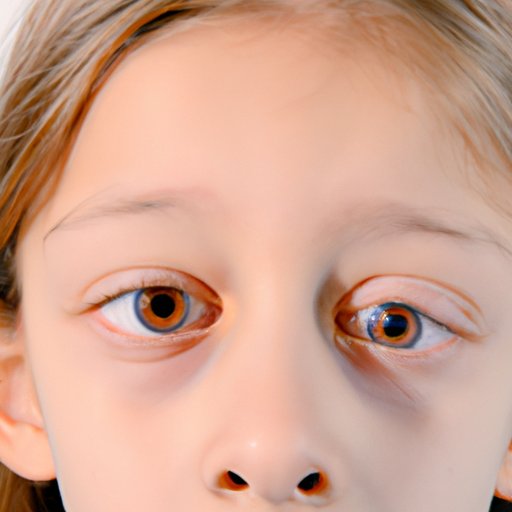
Introduction
A lazy eye, also known as amblyopia, is a common eye condition that affects millions of people worldwide. This condition occurs when one eye does not develop properly in childhood, leading to decreased vision and poor coordination between the eyes. In this article, we will provide a comprehensive guide on how to get rid of a lazy eye, including understanding the condition, its causes, and potential treatments.
Understanding Lazy Eye
A lazy eye is a condition that affects the vision in one eye, while the other eye has normal vision. This condition happens when the brain and eye coordination is disrupted, and the brain starts to favor the stronger eye over the weaker one. A common misconception is that a lazy eye is just a wandering eye, but that is not always the case. In some cases, the affected eye may look normal, but it is not working correctly.
Lazy eye symptoms include decreased vision in one eye, difficulty with depth perception, and poor eye coordination. Individuals with a lazy eye may complain about seeing double or having blurred vision. Children with lazy eye may also develop a preference for one eye over the other, squinting, or tilting their head. If not detected and treated, a lazy eye can lead to permanent vision loss in one eye.
Causes and Prevention
The leading cause of a lazy eye is a developmental problem in childhood, where one eye has a higher refractive error than the other eye. This means that one eye is more nearsighted, farsighted, or astigmatic than the other, leading to a difference in sharpness of vision between the two eyes. The brain then starts to favor the eye with better vision over the weaker one, leading to a lazy eye.
Other contributing factors to develop amblyopia include exposure to toxins, infections, or injuries that affect the eyes’ proper development. Preventing lazy eye involves early detection and treatment of any eye problems such as refractive errors or strabismus. Strabismus can also lead to a lazy eye, so it is essential to have regular eye exams and seek treatment promptly if any issues arise.
Another way to prevent a lazy eye from deteriorating is to engage in activities that require hand-eye coordination, such as playing catch or hitting a ball with a bat. It is also essential to use both eyes equally and avoid covering one eye too much or staring too long at electronic gadgets or screens.
Corrective Treatments for a Lazy Eye
Once a lazy eye is diagnosed, the first step to treatment is to correct any underlying refractive errors with glasses or contact lenses. Common methods of treatment for a lazy eye include patching the stronger eye or using eye drops to blur its vision and train the weaker eye to work harder. These methods can be very effective if started early and followed consistently.
In some cases, eye exercises may be prescribed to help strengthen the eye muscles and improve coordination with the brain. These exercises may include tracking objects with both eyes or playing games that require eye-brain synchronization. Another treatment option for lazy eye is surgery, which may be necessary in severe cases or when other treatments have failed.
The treatment course for a lazy eye varies from person to person, depending on the severity of the condition and the age at which it is detected. Consulting with an eye specialist is the best approach to identify the best treatment method and steps to take.
Vision Therapy
Vision therapy is a specialized form of therapy that helps patients with lazy eye or other vision disorders better coordinate their eye and brain activities. It is an effective technique for treating lazy eye, especially if the patient does not respond well to traditional treatments.
Vision therapy entails special exercises and activities designed to improve vision, eye coordination, and visual processing skills. The therapist may use prisms, filters, or specialized computer programs to help the patient improve their visual abilities. Examples of vision therapy exercises include eye-focusing activities, balance games, and tracking exercises.
Vision therapy is usually done in a clinical environment under the guidance of a trained specialist. The duration of therapy depends on the severity of the condition and the patient’s response to treatment.
Personal Stories
Many people with lazy eyes have successfully treated it with the aid of corrective treatments or vision therapy programs. With regular treatment and consistent effort, it is possible to improve vision and overcome a lazy eye.
One significant advantage of vision therapy is that it teaches you how to use both your eyes correctly, allowing for better-depth perception and improved reading ability. Many success stories demonstrate how vision therapy has helped individuals overcome learning disabilities and improve their overall quality of life.
Tips for Improving Vision
Proper eye care habits can positively impact vision and help overcome lazy eye. Regular eye exams, good lighting, frequent breaks, regular exercise, and a healthy diet can all help improve eye health. In particular, good lighting, frequent breaks, and proper posture when reading, working, or using electronic devices are crucial for avoiding eye strain and improving eye health.
Conclusion
If you suspect that you or your child has symptoms of a lazy eye, it is essential to seek prompt medical attention from an eye specialist. Early detection and treatment make a significant difference in managing the condition and preventing permanent vision loss.
Treatments for a lazy eye include corrective lenses, patches, eye exercises, surgery, and vision therapy. With the appropriate treatment course, it is possible to overcome lazy eye and improve eye coordination, allowing you to enjoy life to the fullest.





